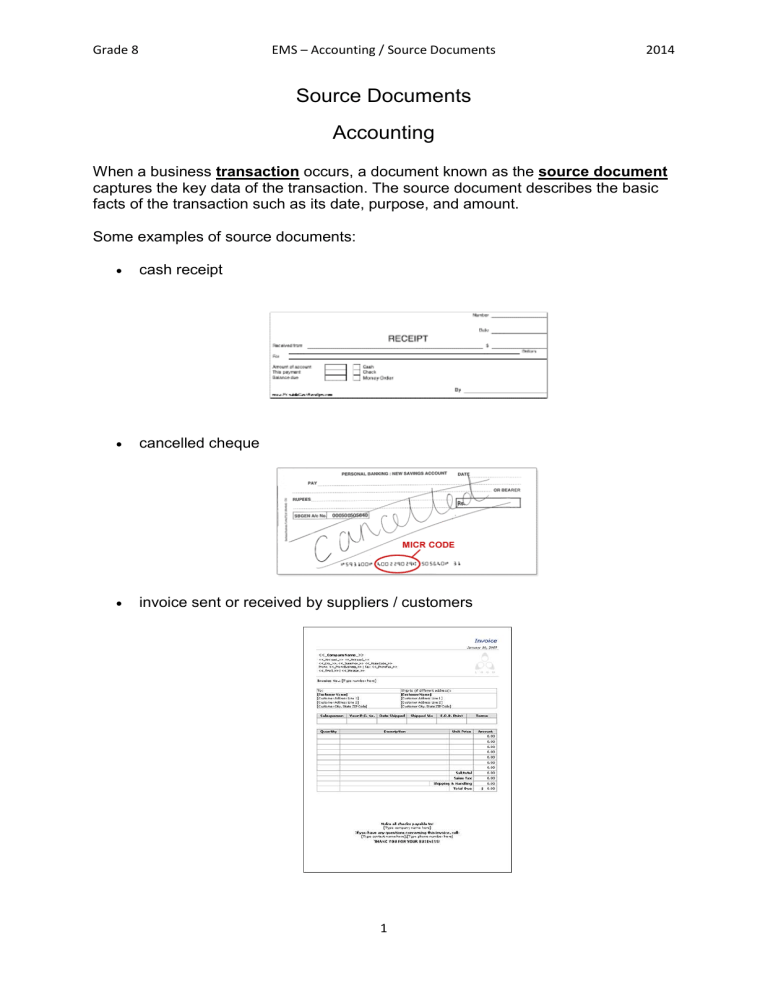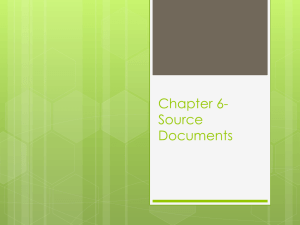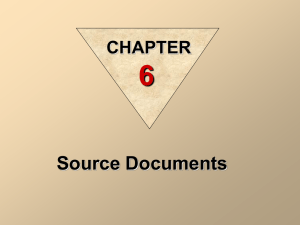
Grade 8 EMS – Accounting / Source Documents 2014 Source Documents Accounting When a business transaction occurs, a document known as the source document captures the key data of the transaction. The source document describes the basic facts of the transaction such as its date, purpose, and amount. Some examples of source documents: cash receipt cancelled cheque invoice sent or received by suppliers / customers 1 Grade 8 EMS – Accounting / Source Documents 2014 The source document is the initial input to the accounting process and serves as objective evidence of the transaction, serving as part of the audit trail should the firm need to prove that a transaction occurred. To facilitate referencing, each source document should have a unique identifier, usually a number or alphanumeric code. Pre-numbering of commonly used forms helps to enforce numbering, to classify transactions, and to identify and locate missing source documents. A well-designed source document form can minimise errors and improve the efficiency of transaction recording. The source document may be created in either paper or electronic format. For example, automated accounting systems may generate the source document electronically or allow paper source documents to be scanned and converted into electronic images. Accounting software often provides on-screen entry forms for different types of transactions to capture the data and generate the source document. The source document is an early document in the accounting cycle. It provides the information required to analyse and classify the transaction and to create the journal entries; which is the next stage of the accounting cycle. Each time a firm makes a financial transaction, some sort of paper trail is generated. That paper trail is called a source document. If a small business writes a cheque out of its account for office supplies, for example, the source document is the cheque along with the receipt for office supplies. The source document is essential to the bookkeeping and accounting process. It is the evidence that a financial transaction occurred. If a business is audited, source documents back up the accounting journals and general ledger as an indisputable audit trail. 2 Grade 8 EMS – Accounting / Source Documents 2014 Keeping a source document for a business is just like keeping your receipts for taxdeductible items for your personal taxes. You have to have those receipts in case your taxes are audited. The same is true for your business, but you don't just keep receipts for tax deductible expenses. You keep receipts (source documents) for every financial transaction. Here are some more examples of common source documents: computer-generated receipt credit memo for a customer refund employee time card deposit slip purchase order credit card receipts cash register tape / roll [CRR] purchase orders deposit slips notes for loans payment stubs for interest cash receipt This is not an exhaustive list. The source document should be recorded in the appropriate accounting journal as soon as possible after the transaction. After recording, all source documents should be filed away in some sort of system where they can be retrieved if and when they are needed 3 Grade 8 EMS – Accounting / Source Documents Types of sources documents . 4 2014 Grade 8 EMS – Accounting / Source Documents 2014 You will have heard the term "double entry book-keeping". This is an old established system of book-keeping which forms the basis of all accounting systems. Today, of course, firms of all sizes usually use computerised accounting systems. Nevertheless, it is useful to learn a little about the double entry system as this will help you understand how a trial balance is drawn up. Every "transaction" is supported by a business document. What do you understand by the term "transaction", and which documents are we talking about? The transaction is a business deal where goods are exchanged for money. Below is the most common transaction related to the sale or purchase of goods, services, capital items and consumables. If you are a seller and make a sale on credit You produce an invoice You send the original of the invoice to the buyer You retain the copy of the invoice If you are a seller who has goods returned You produce a credit note You send the top copy of the credit note to the buyer You retain the copy of the credit note In this way everybody receives a document as a record of the transaction. 5 Grade 8 EMS – Accounting / Source Documents Cash Register Roll When purchasing small quantities of consumables the document you will receive could be the till receipt or cash register roll (CRR). Study the following CRR and identify what the arrows indicate: - 6 2014 Grade 8 EMS – Accounting / Source Documents Features of an Invoice Invoices are numbered to keep track of sent invoices The invoice usually includes the following information: Name, address of seller and purchaser Date of sale Description of sale (goods or services) Quantity and unit price of what has been sold Details discount if it is provided Total amount of invoice plus VAT (value added tax), if applicable Other (date of payment, terms of sale) 7 2014 Grade 8 EMS – Accounting / Source Documents Cheques: 2014 This document instructs the bank to withdraw money from your personal account and pay it to another person. Once the payment has been made, the cashed cheque is returned to you as proof that payment has been made. The cheque counterfoil (stub) is a copy of the information that serves as provisional proof of the transaction. Research information on cheques and tackle the following questions: - 1. What are the advantages of cheques? 2. Who are the parties to a cheque? 3. Why is a cheque crossed? 4. Can alterations be made on a cheque? 5. What reasons can a bank refuse payment on a cheque? 6. What measures are applied to cheques to avoid forgery? 8 Grade 8 EMS – Accounting / Source Documents 2014 7. Explain what the caption below represents and the implications. 8. Explain the difference between a bearer and an order cheque. 9. Complete the cheque below by identifying the components indicated: - 9 Grade 8 EMS – Accounting / Source Documents Deposit slip Study the document above and answer the following questions: 1. What is the name given to the bank that receives the money? 2. What information should be filled in on the deposit slip next to each of the following numbers? 1 2 3 4 5 6 7 10 2014 Grade 8 EMS – Accounting / Source Documents 2014 Data Response on Source Documents Mr Smith purchases ten 100 kg bags of plain white flour from Mr Jones. The flour is delivered the next day and Mr Smith checks a random sample to make sure that the flour is acceptable. The next day he opens one of the bags and discovers that it contains brown flour instead. After a check of all the bags Mr Smith realises that this is the only bag of brown flour and he subsequently returns it. Mr. Smith needs the extra bag of white flour for an order which is due out that day. Unfortunately, Mr. Jones has no further bags of white flour in stock Because of this, Mr. Smith goes to the cash and carry to buy the white flour necessary to complete the order. For this transaction he pays by cash. Question 1. What document does Mr Smith receive (and what copy) as a record of the original transaction? Question 2. What document does Mr. Jones retain (and what copy) as a record of the return of the flour? Question 3. What document does Mr. Smith receive as a record of his purchase of flour at the cash and carry? 11




